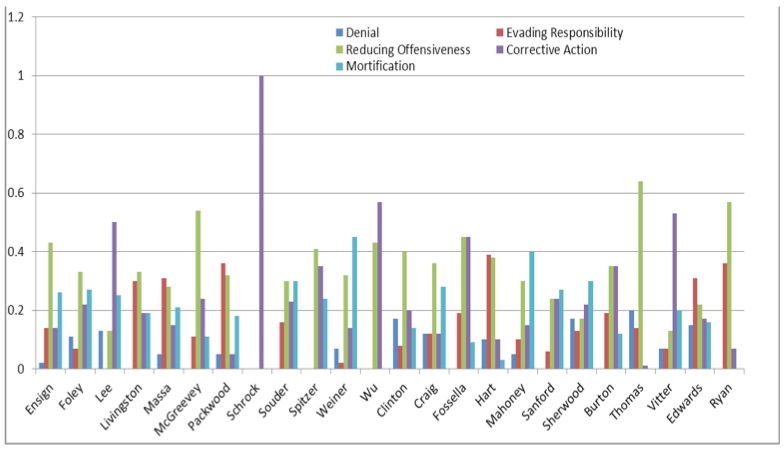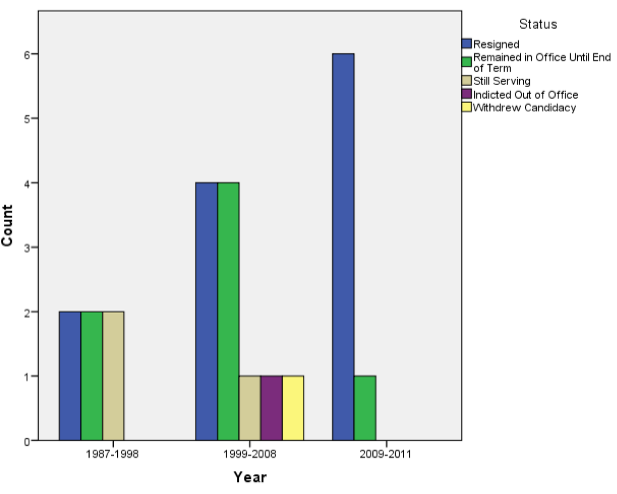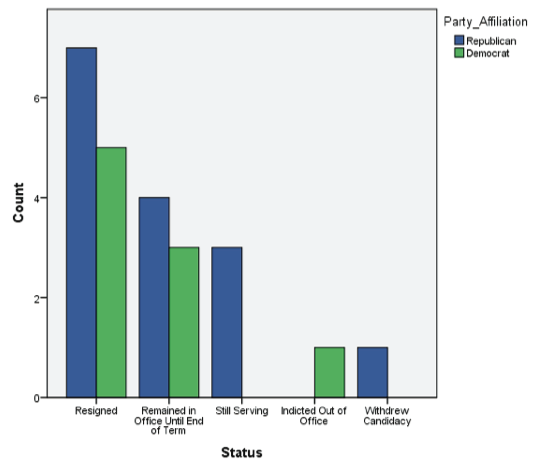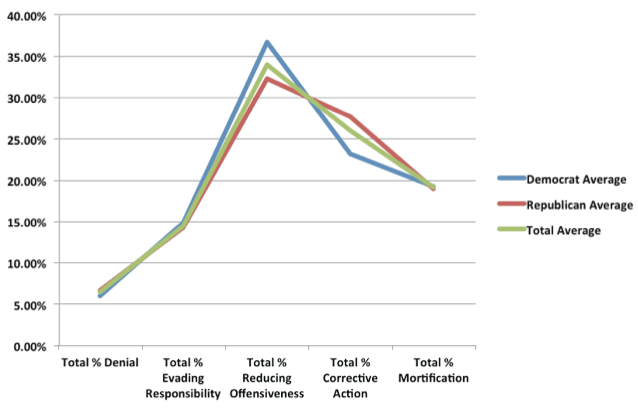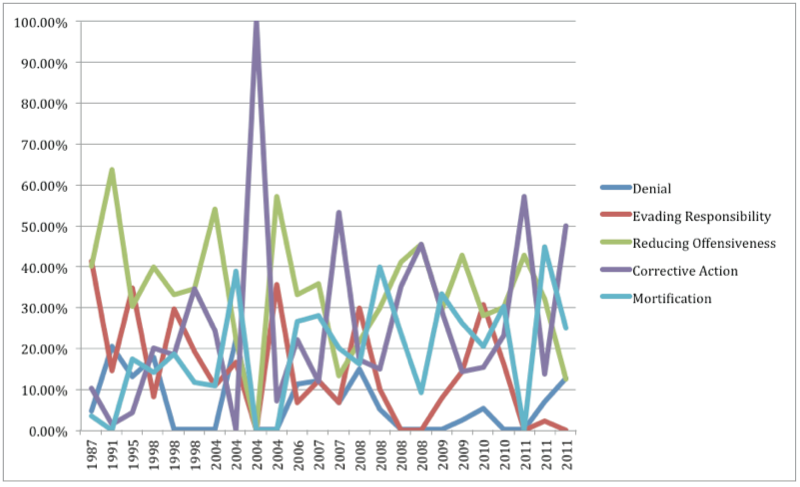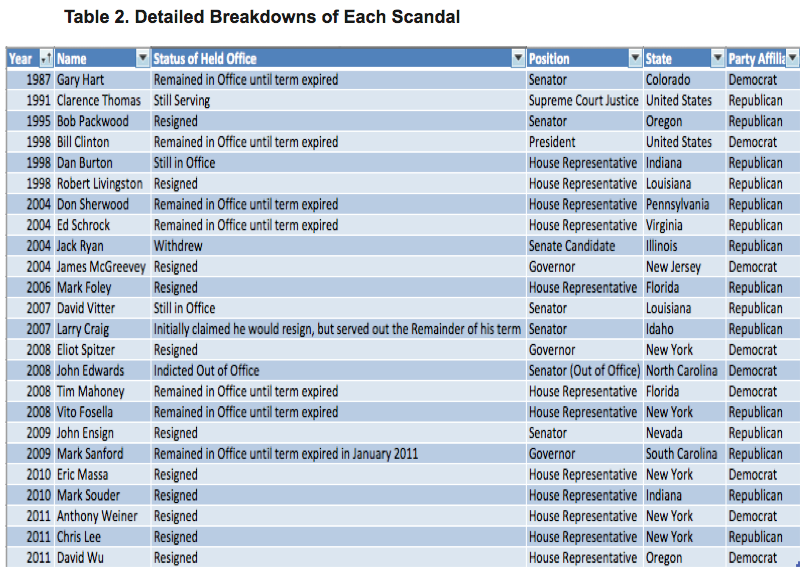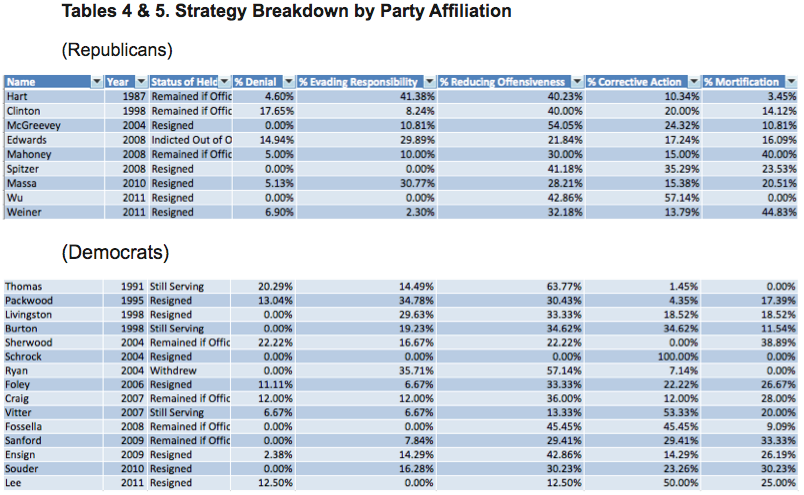From Elon Journal of Undergraduate Research in Communications VOL. 3 NO. 2Image Restoration in Political Sex Scandals: What To Do (And What Not To Do) When You're Caught With Your Pants Down
IN THIS ARTICLE
KEYWORDS
AbstractThis study sought to apply a Crisis Communications lens to the area of American political sex scandals. Applying William Benoit's "Theory of Image Restoration" to 24 American sex scandals, ranging from 1987 to 2011 and all of which received significant national attention, this study examined each official's public statements in response to allegations of sexual impropriety and coded them for their adherence to the five strategies outlined in Benoit's work. The study found "Evading Responsibility" to be most frequently used, while "Denial" was the least utilized of his tactics. This study served to help answer the question of whether or not today's politicians are held to a higher standard, and what this means for the future of political accountability. I. IntroductionOn December 3, 2011, amidst looming allegations of sexual impropriety and harassment, Herman Cain, Chairman of the Federal Reserve Bank of Kansas City and hopeful Republican Presidential nominee, suspended his campaign after "a lot of prayer and soul-searching" (NY Times, 2011). The scandalous allegations were covered in both print and online news, with bloggers and late-night talk show hosts eager to comment on Cain's indiscretions. While sex scandals are by no means new to American Politics, the recent onslaught of new and faster media of the past two decades has dramatically fixated the public's attention on instances of political misconduct, and in doing so, has increased the frequency with which scandals are publicized. Whereas sex scandals of the 1950s and 60s were largely concealed due to the limited number of media outlets, today's media landscape consists of a seemingly endless parade of journalists, bloggers, and gossip sites. A second area in which increased scandals have affected politics is in the standard of accountability to which politicians and officials are now held. Almost every month there is a new story of impropriety, and calls for the targeted individual to respond to allegations and explain himself or herself. The rapid growth of the Internet as well as new media outlets has led to increased scrutiny of virtually all areas of political public affairs, but has also led to an information-driven society in which private lives can easily be made public. This study sought to examine political sex scandals with a Crisis Communications lens. By understanding the strategies and tactics used by each official in response to allegations against him, this paper outlined the most effective methods used, and examined if there are certain variables (party affiliation, year of scandal) that can serve as a predictor of response. Because of the increased publicity of sex scandals, even just in the past decade, this paper explored the various techniques that officials and their press offices used to combat the negative press surrounding the reported event. By reading and analyzing public statements made from each official in response to allegations, the author hoped to find an explanation as to why some image restoration strategies were used more than others, and perhaps clarify what makes the aftermath of one scandal more successful than another. Crisis management is generally discussed on an organizational or corporate level, so by applying the same image restoration theory to individual scandals and political crises, this paper sought to determine which strategies are most highly regarded, and why some are more effective than others in quashing negative public opinion. II. Literature ReviewScandals by Definition and PracticeTo determine the expectations of effectively managing and controlling scandals, it is important to first understand what constitutes a scandal. Political rhetoric scholar, John Thompson, argued that for an event to be a scandal rather than simply a piece of news, it must include five specific characteristics. First, the event must involve a "transgression of certain values, norms or moral codes" (Thompson, 2000, p. 14). Second and third, the incident must include some aspect of secrecy, and there also must be a level of disapproval by nonparticipants surrounding the action. Fourth, there must be "public denouncing" of the actions or events by nonparticipants and finally, that the actions must "damage the reputation of the individuals responsible for them" (Thompson, 2000, p. 14). Because cultural and societal norms vary throughout history and region, there is a level of scandal sensitivity that must be considered; what constitutes a scandal for some may not for others. Additionally, David Rosen has written that scandals do not take place in an "historical vacuum," but rather arise a great deal of their meaning as a result of the culture and context in which they occur (Rosen, 2009, p. 11). Perpetrators of a scandal or transgression, as a result of the current political spectrum and increased media attention and scrutiny, can largely be divided into two categories: "Those living a lie and those living out a lifestyle" (Rosen, 2009, p. 9). Politicians largely fall into the first category, feeling that they have something to hide, something that would undermine their public image, and choose instead to "go for the moral high ground," and cling to values that would separate themselves from a given action (Thompson, 2000, p. 23). Clinging to that high ground, however, in response to scandal can be a risk in that publics are more likely to criticize or mistrust a representative deemed a hypocrite. In observing the differences in sexual and financial political scandals, David Doherty has found that "a representative who has previously taken a strong stance in favor of 'family values' and who is later caught in an infidelity scandal may be punished particularly harshly" (Doherty, 2011, p. 753). In scandals, William Benoit has written that "perceptions are more important than reality" and thus, when allegations are made against an official, whether or not there is evidence initially, the public's view of him shifts, and it becomes his job to tailor his response to a specific public (Benoit, 1997, p. 178). In a media climate filled with 24-hour news stations, extreme polarization of political parties, and a growing need to both entertain and inform the public, scandals are no longer mere judgments on moral wrongdoings, but are deliberate political acts with intended outcomes (Rosen, 2009, p. 12). When sex scandals increased in frequency throughout the 1990s, a pattern began to emerge in the process by which officials would respond: "attack, apology, and community expulsion" (Achter, 2000, p. 324). This narrative frame enabled rhetorical scholars to explore trends in scandals and image restoration, and how scandals were handled in different cultural and historical contexts. Political Responses to ScandalsDue to the rise of the Internet and new media outlets entering the 21st century, there has been a dramatic increase in the number of political sex scandals uncovered, and with it, public statements, speeches, and apologia in response to allegations. Candidates and elected officials today are held to a much higher moral standard than those elected officials campaigning before the Internet and advent of social media "since their improprieties will be fodder for late-night comedians, websites, partisan news channels, and talk radio outlets" (Dagnes, 2011, p. 8). While they have historically been held accountable for their actions by the constituents they represent, today's politicians must also realize that their conduct can easily receive national attention if it is deemed a scandal (Aday, 1998, p. 857). While coverage can be reported nationally, the overall outcome of a scandal is largely dependent on demographics and societal norms of a specific constituency. Although the scandal may be covered on a national level, the politician must address his constituents specifically, and cater his message to best mirror the values and norms of those he is representing (Dagnes, 2011, p. 7). By applying John Dowling's work on organizational legitimacy to elected officials, it appears that in order to win back their targeted public, he or she must work to "establish congruence" between the social values associated with their actions and the "norms of acceptable behavior" in the area they are representing (Dowling, 1875, p. 122). Officials must align their response or apology with the values of their own constituency, which is why the content of public apologies varies. Ultimately, it is the decision of one's constituency and the voting public that will determine his or her political future, as long as the official knows his public well enough to understand how to "behave in the face of adversity" (Dagnes, 2011, p. 89). Goals of Crisis ManagementOnce "scandal" is defined within the parameter of American politics, it is important to then understand the role of public statements and communication in combating or controlling negative events. Although crisis communication was initially explored through a frame of business, the basic elements of a successful strategy are mirrored in an individual's response. Matthew Seeger has written that "a crisis creates high levels of uncertainty with key stakeholders and thus an intense need for immediate communication about important information" (Seeger, 2010, p. 128). In the case of political scandals, key stakeholders represent an official's public, and he or she must tailor a response to satisfy the goals and expectations of that audience. Image restoration strategies in political scandals, then, echo the tactics used in crisis response plans of business, because maintaining reputation and public perception are paramount in both fields (Seeger, 2010, p. 130). Heralded as the architect of perhaps the most widely accepted theory of image restoration strategies in crisis management, William Benoit believed that communication in all forms was goal-oriented, but was defined more narrowly by genre criticism (rhetoric), and analyses of "guilt, purification, and goals" (Burns, 2000, p. 29). Maintaining a positive reputation and image, Benoit has argued, is one of the most central goals of communication. He wrote that "as human beings, we inevitably engage in behavior that makes us vulnerable to attack," and that these allegations can manifest themselves as an attack one's reputation (Benoit, 1995, p. 67). There are two main components that must both exist in order for an action to threaten one's reputation: "(1) An act occurred which is undesirable, (2) You are responsible for that action" (Benoit 1995, 71). When one's reputation is threatened, Benoit argued that he or she would feel compelled to offer "explanations, defenses, justifications, rationalizations, apologies, or excuses" for the damaging behavior (Benoit, 1995, p. 70). His "Theory of Image Restoration" established a set of five strategies of image repair evident in virtually every response to scandal. He attempted to determine why an individual is more inclined to use one strategy than another, and how each strategy satisfies a certain goal of communication. Theory of Image RestorationBenoit's five strategies of Image Restoration are: Denial, Evading Responsibility, Reducing Offensiveness, Corrective Action, and Mortification (Benoit, 1995, p. 74). He defines denial as, "the accused [denying] that the offensive act actually occurred or denies that he or she performed it" and finds that, if the public accepts this denial, he or she should be relieved of any blame for the action (Benoit, 1995, p. 75). In evading responsibility, "the actor attempts to suggest that lack of information, volition, or ability means that he or she should not be held fully responsible for the act" (Benoit, 1995, p. 76). Reducing offensiveness, the most inclusive of Benoit's strategies, occurs when the accused "attempts to reduce the unfavorable feelings toward the actor by increasing the audience's esteem for the actor or by decreasing their negative feelings about the act" (Benoit, 1995, p. 78). The category includes six different techniques: bolstering, minimization, differentiation, transcendence, attacking one's accuser, and compensation (Benoit, 1995, p. 77). The fourth strategy, corrective action, may take two forms: "restoring the situation to the state of affairs before the objectionable action and/or promising to 'mend one's ways' and make changes to prevent the recurrence of the undesirable act" (Benoit, 1995, p. 79). The final strategy, mortification, occurs when the accused "admits responsibility for the wrongful act and asks for forgiveness" (Benoit, 1995, p. 79). This study uses Benoit's theory as a way of coding each public statement made in response to allegations of misconduct, to determine which methods were used most frequently, and by whom, and in which contexts. Political Sex Scandals in Today's Media LandscapeRegardless of which image restoration techniques an individual utilizes, the salacious nature of sex scandals will ensure that the scandal, whether on a national or state level, receives significant national attention (Carpini, 2001). Prior to the emergence of the Internet, bloggers, and the growing number of news outlets, politicians as well as their publics could distinguish between public and private lives, and officials were largely protected from the probing nature of today's media climate (Carpini, 2001, p. 168). There was a perimeter around a candidate's family and private life that news outlets abstained from entering—a concept foreign in today's media outlets. "Shaming," notes David Rosen, "has become a form of entertainment, meant to distract or fascinate the public—a twenty-first century gladiator sport with the camera replacing the lion" (Rosen, 2009, p. 8). The sheer frequency with which scandals are unearthed today represents a public struggle between being entertained and disgusted by the significant attention news outlets place on scandals (Williams, 2004, p. 3). Juliet Williams writes that Americans on both sides of the ideological spectrum "wonder whether so much fanfare over the sexual lives of political leaders is genuinely necessary to a well-functioning polity" (Williams 2004, p. 3). Given the need for media outlets to profit, they often look for the most scintillating stories, the ones that will entertain the public and draw the largest audience. No longer is reporting on policy or congressional proceedings enough; "In a climate where candidates must rely heavily on popular approval, reporting is equated with investigating, personalities prevail over issues, and scandals flourish" (Achter 2000, p. 320). Paul Achter writes about the emergence of the "media scandal," in which the media assigns a narrative form to scandal, developing a complex story focused around the rhetoric and behavior of a given official. In today's media structure, "at the very moment an allegation is made, a scandal is born" (Achter 2000, p. 319). A candidate's background is rummaged through for the faintest trait of impropriety or misconduct, giving way to a political system in which politicians must convey morality in every facet of their lives, both publicly and privately. Virtually all literature written on this separation cites President Bill Clinton's affair with Monica Lewinsky as a turning point in "the distinction between private and public character" (Aday 1998, p. 856). The attention paid to President Clinton's affair while in the White House marked the beginning of the "ubiquitous presence and coverage by the modern media," and with it emerged a journalistic grey area between news and entertainment (Dagnes, 2011, p. 12). Hard news outlets began to include more lewd details in their coverage and "traditional journalism lost its position as the central gatekeeper of the nation's political agenda" (Carpini, 2001, p. 174). No longer were news outlets as concerned with providing the "facts"—even the most traditional media outlets understood that covering the scandal attracted a larger audience, and so they "adapted to the new rules by increasingly mimicking the form of substance of its new media competitors" (Carpini, 2001, p. 174). This scandal served as an archetype for those to follow: no crevice of a politician's life was off limits, with news organizations trying to fill their 24-hour cycles with stories that would attract the largest possible audience (Carpini, 2001). Realizing that scandals attracted larger audiences, news outlets and Internet sites began delving deeper into the private lives of officials, searching for misconduct or any behavior that strayed from societal norms (Carpini, 2001, p. 168). President Clinton as a Deviation from Scandal 'Norms'The vast majority of officials involved in a sex scandal understand and accept that the publication of their transgressions likely signifies the end of their career, most of whom elect to resign or not seek reelection. Given this understanding, many scholars have closely examined the case of President Clinton to uncover why he was able to emerge from scandal with his public opinion virtually unscathed (Just, 2000, p. 179). With unprecedented national attention paid to his affair with Monica Lewinsky and his impeachment hearings, many believed that his image would be forever tarnished as accusations surfaced, which concerned his conduct both as a "public servant and private citizen" (Woessner, 2005, p. 97). What made Clinton able to withstand the constant public scrutiny was the fact that his leadership image was not centered around morality, but rather specific policy areas and domestic successes (Just, 2000, p. 179). Marion Just finds that ultimately "President Clinton was able to preserve his public image through the impeachment debacle in large part because of low public expectations about his personal moral behavior" (Just, 2000, p. 179). As the scandal broke out in 1998, in the transition of media focus from public to private lives, the public was able to accept Clinton's affair because they had not elected him because of his ethical character, but because they believed he was best suited to serve the office of the Presidency. Joseph Blaney feels that the level of attention paid to political scandal is too great, asking, "Do we want our Chief Executive and Commander-in-Chief distracted by scandal when facing decisions of great domestic and foreign importance?" (Blaney, 2001, p. 1). Today, however, candidates must prove themselves equally as being good and decent citizens as well as individuals with strong ideas and exceptional awareness of the qualities and challenges of being a fit and faithful leader. Exploring the different actors involved in the publication of, response to, and image restoration strategies following scandal, it is crucial to understand how the system has shift, and the impact of media on political responses. Representatives must continuously prove that they are moral, establishing a political system in which rhetoric and personality have become more important than intellect and good judgment. Using a crisis communication lens in order to analyze different political scandals, this study sought to find patterns and trends in the way in which history, context, and media have changed the nature of response, and the image restoration strategies used most frequently today. It is important to understand that although scandals are in no way a new issue in politics, the fusion of public and private lives of officials had led to new scandals being uncovered virtually every month. In applying William Benoit's "Theory of Image Restoration" to American political sex scandals, this study demonstrates how different strategies were implemented pre-Internet, during its emergence, and in today's information/entertainment driven media landscape.Continued on Next Page » Suggested Reading from Inquiries Journal
Inquiries Journal provides undergraduate and graduate students around the world a platform for the wide dissemination of academic work over a range of core disciplines. Representing the work of students from hundreds of institutions around the globe, Inquiries Journal's large database of academic articles is completely free. Learn more | Blog | Submit Latest in Business & Communications |

